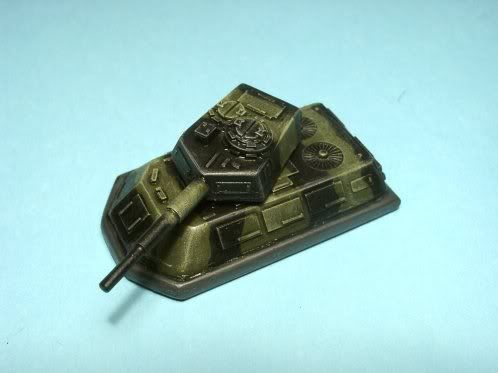Apollo-class Main Battle Tank

Name/Type: Apollo-class Main Battle Tank
Designer/Manufacturer: Confederation Defence Industries
Combat Role: Main Battle Tank
Crew: 3 (Commander, Driver, Gunner).
Length: 10 meters
Propulsion: Repulsorlift, hover engine
Speed: 360 kph
Shield Rating: None.
Hull Rating: 150 RU
Weapons: 1 CCA I-2 Repeating 90mm Cannon, 1 CCA IV-8 Dual Laser Cannon, 8 CSPL-12 "Caspel" Projectile Launchers.
Cargo Capacity: None.
Special: Active Camouflage, Non-Energetic Reactive Armor.
Basic Description: The Apollo-class is a lightly armed, highly mobile tank created for various missions ranging from scouting to front-line combat. With powerful repulsorlifts and auxiliary hover engines, the Apollo excels at rapidly traversing all matters of terrain, from spacious deserts to cluttered forests. Unfortunately, it is a relatively small, and only moderately armed and armored compared to many newer designs. However, the equipment that it does possess is of good quality and design, which rectifies many of the tank’s shortcomings. Because of their somewhat weak skin and complete lack of shielding, Apollos rely primarily on evasion for their defence; using their excellent maneuverability and photoreactive skin to avoid detection and effective targeting. Because of this design philosophy, Apollos typically use hit-and-run or ambush tactics to defeat their opponents.
Technical Descriptions:
Relative Cost: Average
Cost: The Apollo MBT was intentionally designed to be easy to produce, modify, and repair; much like the Unity Program ships. The frame, basic systems, and propulsion can all be manufactured almost anywhere where even the smallest industrial infrastructure exists or can simply be replaced with civilian landspeeder parts. However, this relatively small costs are offset by the high-end main gun, sensors, and photo-reactive armor.
Speed: Moderately High
Engines: Engines occupy almost a third of the tank’s chassis. It repulsor engines, often civilian landspeeder models, make it faster than most tanks currently being used throughout the galaxy, though there are a few older tanks such as the S-1 Firehawke which actually are faster than it. More interesting are the inclusion of auxiliary hover engines, which grant the Apollo a higher altitude and the ability to penetrate theatre shields. If the repulsorlifts fail, the hover engines are capable of moving the tank around at a reduced speed.
Shield Rating: Nonexistent
Shields: Shields don’t exist on this craft. Instead, power normally expended on them was transferred to power everything else.
Armor: Moderately High
Armor: Because the Apollo lacks shielding, it was vital that it could survive a few hits to its hull. To this end, the tank incorporates a heavily sloped hull and Non-energetic Reactive Armor to lessen damage from projectile weapons such as shells or missile. Against laser weapons, the Apollo’s armor is between that of an AT-AT and an AT-ST. But perhaps the armor’s greatest defence is in utilizing photo-reactive fibers like those utilized with the Confederate Army’s Camou Scout Armor to seamlessly conceal the tank in all terrains. Ceraglass is used to cover the slits, providing both excellent protection and vision for the driver and the gunner. Like the Ares-class, The tank is fully sealed from the environment and has internal environmental controls; allowing the crew to operate it even in the most demanding of conditions.
Weapons: Moderately Low
Weapons: While not as heavily armed as many tanks, the Apollo like other Confederation units does not rely on brute power to win battles, but rather well-designed weapons. There are fewer better examples of this than the CCA I-2 Cannon, which while a smaller caliber than equivalent Imperial tanks, works well in tandem with the Apollo’s design philosophy. In order to improve its versatility, the main turret is mounted on a maglev turret like those used on some KDI warships. This gives the Apollo excellent tracking capability, allowing it to even hit some nearby aircraft. Also included on the turret is a retractable, turreted dual laser cannon, used for anti-missile defence and against smaller ground targets such as speeder bikes or enemy troopers. Lastly, a set of eight Caspel launchers are carried concealed in the back of the turret. These are primarily used to support infantry operations. Besides a typical array of targeting sensors, mostly EPRs, the Apollo carries a Novaless Soni-Optics Target Imager, also used on the Paladin II, and an exceptionally powerful Infrared Receptor.